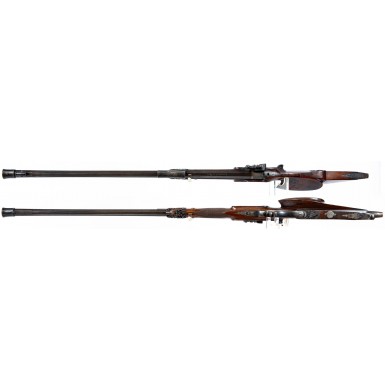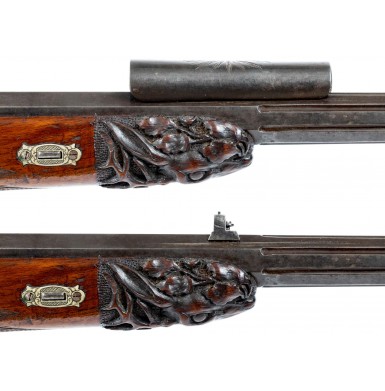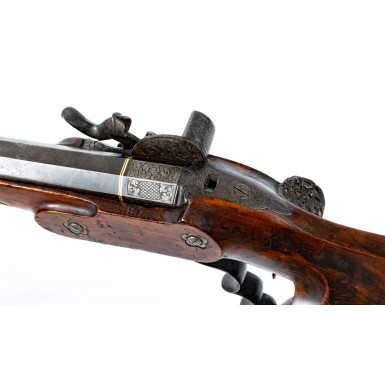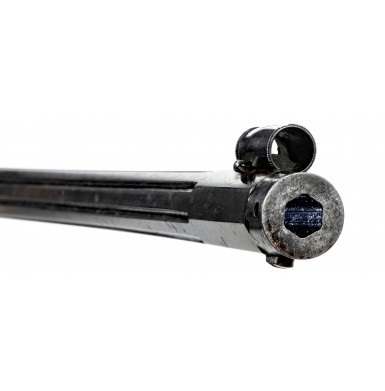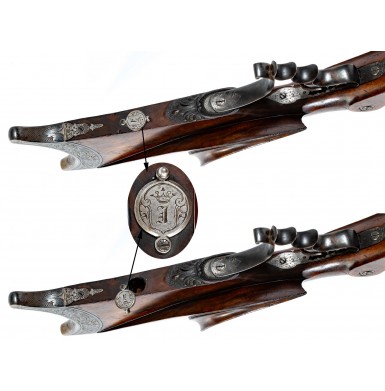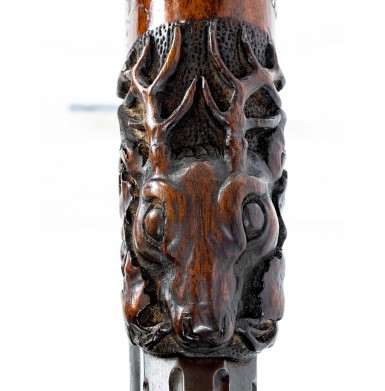Fine Percussion Austrian Schuetzen Rifle by Bartusch of Vienna
- Product Code: FLA-3628-SOLD
- Availability: Out Of Stock
-
$1.00
During the mid-19thcentury the muzzleloading target rifle reached its pinnacle of design in Europe, where many of the Germanic countries, including the various German states, Austria and Switzerland all had a long history of target shooting and competition. German immigrants had been largely responsible for the development of the American rifle making industry in the mid-18thcentury and were the makers responsible for the birth of the “Kentucky” (Pennsylvania) Rifle. 19thcentury German immigrants had established Turner Societies in America, German-American athletic and cultural clubs that centered much of their activities around competitive target shooting. During the American Civil War, many of these Turner’s would volunteer en masse to become the foundation of several German-speaking Union Regiments.
In Europe, the “Schuetzen” (Schützen) matches were traditionally shot at 200-meters, in America this was translated to “Forty Rods”, with a “rod” being five and a half yards, equating to 220-yards, almost exactly 200-meters! While the tradition began in the Germanic states with numerous German makers producing highly accurate target rifles, the form reached high art with the Swiss to took the design of these rifles to their pinnacle with exquisitely carved stocks and engraved metal. In Austria, which boarders Switzerland to the East, the Germanic rifles developed into a fine target rifles as well, with Swiss influences finding their way into the stocks and furniture of the rifles. These features are most noticeable in the buttstocks that often feature the Swiss-style extended lower tang at the toe and in the oversized, skeletonized, finger-grooved triggerguards. As in Germany and Switzerland, as the rifles continued to evolve and the makers became more capable, the guns became more and more customized to fit a specific customer and became works of art as well as precision rifles.
One of the premier makers of Austrian Schuetzen Rifles was Franz Bartusch of Vienna. Sources give different dates for his period of operation, with some saying he was active circa 1840-1860 and Stockel listing him as active circa 1850-1860. The quality of his rifles earned him order from numerous members of the European royalty and gentry, with King Leopold II of Belgium being one of Bartusch’s clients. Bartusch often used cast steel in his barrels (typically marked “Aus Guss Stahl”), at a time when many rifles were still made of malleable iron. He also used high quality barrels made by other makers, was appropriate. His rifles were well known for their high quality and accuracy. When encountered today, his rifles often bear the crests of the European nobleman who had ordered the gun.
The Franz Bartusch Schuetzen Rifle offered here measures 42 ½” in overall length with a 31 3/8” barrel. The blued steel barrel is octagonal, with the first 11 7/8” tapering gently to a section that has eight 16 7/8” flutes cut in it to lighten it. The last 2 ¾” return to full-octagon and are gently swamped towards the muzzle. The original 1 3/8” long flared false muzzle remains with the rifle. When in place, the false muzzle adds about 1” to the length of the barrel. The barrel is rifled with six grooves and is nominally .44 caliber, roughly 11mm. The barrel is retained by a single wedge through the forend and the screw through the breech plug tang. It is clearly engraved on the top flat: F. Bartusch in Wien in a Gothic style, with the left angled flat engraved AUS GUSS – STAHL and the right angled flat engraved GERBOTHER – LAUF. The top flat is lightly stippled from the breech to the rear sight, to reduced glare on the top of the barrel. The top of the breech is engraved with tight flowing foliate scrolls, with the left and right angled flats of the breech engraved with a geometric lattice pattern bordered by a foliate scroll boarder. The breech plug tang is engraved en-suite and a pair of gold bands further decorate the breech of the rifle. The reversed percussion lock has an integral engraved flash guard. The lock is profusely engraved with tight foliate scrolls and in two lines:
BARTUSCH
IN WIEN
The lock is secured by two screws that pass through lightly engraved flower shaped escutcheons. The triggerguard has an extended finger-grooved, skeletonized grip with engraved tang and front finial. The lock has adjustable double-set triggers that are extremely responsive, with the rear-most trigger finely checkered. According my trigger-pull gauge it takes about 10-pounds of pressure to set the rear trigger and only about two-tenths of an ounce to release the front trigger! The lock has both half-cock and full-cock positions. The semi-Swiss style blued steel butt plate is engraved with following scrolls with the same motifs engraved on the lock and breech. The rear sight has a target blade that is screw-adjustable for elevation and drift adjustable for windage. It is covered by a removable sunshade that is 3 7/16” long and engraved with a smiling anthropomorphic sun-face image that radiates rays in all directions. The front sight is a dovetailed globe with a drift adjustable hooded post. The hood is engraved with what appears to be a Gothic L. This same letter, surmounted by a crown, is engraved on the grease cover in the belly of the stock. The breech tang is cut for peep sight post, but the sight has been lost to the ages. The rifle is stocked in an alpine fashion with a Swiss influenced half-stock that does not have as exaggerated lower tang on the buttplate as most Swiss rifles but shows the influence. The stock has an exaggerated raised cheek rest with a concave surface and a fairly dramatic drop, roughly 1 ½” at the comb and 4 ½” at the heel. The length of pull of the rifle is rather short 12”. The stock is deeply carved with floral motifs at the comb with a deeply textured raised thumb rest. The rear tang of the triggerguard is carved with a raised pineapple motif and tip of the forend has a deeply carved stags head decorating it. The forend is additionally finely checkered.
The rifle remains in about FINE overall condition. The barrel retains about 20% thinning blue, evenly mixed with a mostly smooth, lightly oxidized plum brown patina. There are some minor flecks of surface oxidation shot through the thinned blue on the barrel. The blued steel furniture retains slightly more thinning blue, maybe 30%, mixed with a similar plum brown patina. The lock retains even more blue, approaching 40%, but again showing thinning fading and dulling. All of the markings and engraving in the metal parts remain clear and crisp, with all markings fully legible. The action of the rifle functions flawlessly, with an amazingly crisp and light trigger. The bore of the rifle is in FINE condition. It is mostly bright with crisp rifling that shows some frosting in the grooves and some very lightly scattered minor pitting. The original false muzzle is in equally fine and crisp condition but is missing the two small set screws that allow it to be secured to the muzzle. The stock is in FINE condition as well. It is solid, full-length and free of any breaks, cracks or repairs. The carving all remains crisp and sharp and the stock has never been sanded. The wood does show some scattered minor bumps, bruises and handling marks, but remains very crisp and fine throughout.
Overall this is a really wonderful and somewhat unusual example of a very high quality percussion Austrian target rifle from the end of the percussion era. This wonderful signed gun would be equally at home in a quality collection of target rifles or back on the range, where I am sure it would be a real tack driver.
SOLD
Tags: Fine, Percussion, Austrian, Schuetzen, Rifle, by, Bartusch, of, Vienna




